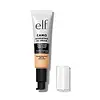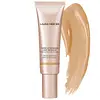e.l.f. cosmetics Camo Hydrating CC Cream Versus Laura Mercier Tinted Moisturizer Light Revealer Natural Skin Illuminator SPF 25 PA+++
What's inside
What's inside
 Key Ingredients
Key Ingredients

 Benefits
Benefits

 Concerns
Concerns

 Ingredients Side-by-side
Ingredients Side-by-side

Zinc Oxide 6.3%
Cosmetic ColorantTitanium Dioxide 6%
Cosmetic ColorantHomosalate 5%
Skin ConditioningEthylhexyl Salicylate 4.5%
UV AbsorberOctocrylene 3%
UV AbsorberWater
Skin ConditioningDimethicone
EmollientButylene Glycol
HumectantCetyl PEG/PPG-10/1 Dimethicone
EmulsifyingButyloctyl Salicylate
Skin ConditioningButylene Glycol Dicaprylate/Dicaprate
EmollientPanthenol
Skin ConditioningSynthetic Fluorphlogopite
Polyglyceryl-4 Isostearate
EmulsifyingMagnesium Sulfate
Acrylates/Polytrimethylsiloxymethacrylate Copolymer
Skin ConditioningTrehalose
HumectantPhenoxyethanol
PreservativeHydrated Silica
AbrasiveDisteardimonium Hectorite
StabilisingTriethoxycaprylylsilane
Hydrogen Dimethicone
Aluminum Hydroxide
EmollientTriethyl Citrate
MaskingEthylhexylglycerin
Skin ConditioningCaprylyl Glycol
EmollientDisodium EDTA
Tin Oxide
AbrasiveTocopheryl Acetate
AntioxidantTremella Fuciformis Extract
HumectantSodium Hyaluronate
HumectantNiacinamide
SmoothingAscorbyl Palmitate
AntioxidantCanola Oil
EmollientGlycerin
HumectantDaucus Carota Sativa Seed Oil
Emollient1,2-Hexanediol
Skin ConditioningDaucus Carota Sativa Root Extract
Skin ConditioningHelianthus Annuus Seed Oil
EmollientBeta-Carotene
Skin ConditioningSoluble Collagen
HumectantCI 77891
Cosmetic ColorantCI 77492
Cosmetic ColorantCI 77491
Cosmetic ColorantCI 77499
Cosmetic ColorantZinc Oxide 6.3%, Titanium Dioxide 6%, Homosalate 5%, Ethylhexyl Salicylate 4.5%, Octocrylene 3%, Water, Dimethicone, Butylene Glycol, Cetyl PEG/PPG-10/1 Dimethicone, Butyloctyl Salicylate, Butylene Glycol Dicaprylate/Dicaprate, Panthenol, Synthetic Fluorphlogopite, Polyglyceryl-4 Isostearate, Magnesium Sulfate, Acrylates/Polytrimethylsiloxymethacrylate Copolymer, Trehalose, Phenoxyethanol, Hydrated Silica, Disteardimonium Hectorite, Triethoxycaprylylsilane, Hydrogen Dimethicone, Aluminum Hydroxide, Triethyl Citrate, Ethylhexylglycerin, Caprylyl Glycol, Disodium EDTA, Tin Oxide, Tocopheryl Acetate, Tremella Fuciformis Extract, Sodium Hyaluronate, Niacinamide, Ascorbyl Palmitate, Canola Oil, Glycerin, Daucus Carota Sativa Seed Oil, 1,2-Hexanediol, Daucus Carota Sativa Root Extract, Helianthus Annuus Seed Oil, Beta-Carotene, Soluble Collagen, CI 77891, CI 77492, CI 77491, CI 77499
Butyl Methoxydibenzoylmethane 3%
UV AbsorberHomosalate 5%
Skin ConditioningEthylhexyl Salicylate 5%
UV AbsorberOctocrylene 3%
UV AbsorberWater
Skin ConditioningButyloctyl Salicylate
Skin ConditioningButylene Glycol
HumectantOctyldodecyl Neopentanoate
EmollientDimethicone
EmollientGlyceryl Stearate
EmollientPEG-100 Stearate
Glycerin
HumectantAscophyllum Nodosum Extract
Skin ConditioningSilica
AbrasiveEthylhexylglycerin
Skin ConditioningCetearyl Alcohol
EmollientCoco-Glucoside
CleansingCitric Acid
BufferingBatyl Alcohol
EmollientBis-PEG/PPG-14/14 Dimethicone
EmollientAcrylates/C10-30 Alkyl Acrylate Crosspolymer
Emulsion StabilisingDisodium EDTA
Potassium Hydroxide
BufferingTocopheryl Acetate
AntioxidantTetrahexyldecyl Ascorbate
AntioxidantXanthan Gum
EmulsifyingSaccharide Isomerate
HumectantSodium Citrate
BufferingTin Oxide
AbrasivePhenoxyethanol
PreservativePotassium Sorbate
PreservativeIron Oxides
Mica
Cosmetic ColorantTitanium Dioxide
Cosmetic ColorantButyl Methoxydibenzoylmethane 3%, Homosalate 5%, Ethylhexyl Salicylate 5%, Octocrylene 3%, Water, Butyloctyl Salicylate, Butylene Glycol, Octyldodecyl Neopentanoate, Dimethicone, Glyceryl Stearate, PEG-100 Stearate, Glycerin, Ascophyllum Nodosum Extract, Silica, Ethylhexylglycerin, Cetearyl Alcohol, Coco-Glucoside, Citric Acid, Batyl Alcohol, Bis-PEG/PPG-14/14 Dimethicone, Acrylates/C10-30 Alkyl Acrylate Crosspolymer, Disodium EDTA, Potassium Hydroxide, Tocopheryl Acetate, Tetrahexyldecyl Ascorbate, Xanthan Gum, Saccharide Isomerate, Sodium Citrate, Tin Oxide, Phenoxyethanol, Potassium Sorbate, Iron Oxides, Mica, Titanium Dioxide
 Reviews
Reviews

Ingredients Explained
These ingredients are found in both products.
Ingredients higher up in an ingredient list are typically present in a larger amount.
Butylene Glycol (or BG) is used within cosmetic products for a few different reasons:
Overall, Butylene Glycol is a safe and well-rounded ingredient that works well with other ingredients.
Though this ingredient works well with most skin types, some people with sensitive skin may experience a reaction such as allergic rashes, closed comedones, or itchiness.
Learn more about Butylene GlycolButyloctyl Salicylate is a chemical UV filter structurally similar to octisalate. It is a photostabilizer, SPF booster, emollient and solvent. This ingredient helps evenly spread out ingredients.
According to a manufacturer, it is suitable for pairing with micro Titanium Dioxide, Zinc Oxide, and pigments.
Photostabilizers help stabilize UV-filters and prevents them from degrading quickly.
Learn more about Butyloctyl SalicylateDimethicone is a type of synthetic silicone created from natural materials such as quartz.
What it does:
Dimethicone comes in different viscosities:
Depending on the viscosity, dimethicone has different properties.
Ingredients lists don't always show which type is used, so we recommend reaching out to the brand if you have questions about the viscosity.
This ingredient is unlikely to cause irritation because it does not get absorbed into skin. However, people with silicone allergies should be careful about using this ingredient.
Note: Dimethicone may contribute to pilling. This is because it is not oil or water soluble, so pilling may occur when layered with products. When mixed with heavy oils in a formula, the outcome is also quite greasy.
Learn more about DimethiconeDisodium EDTA plays a role in making products more stable by aiding other preservatives.
It is a chelating agent, meaning it neutralizes metal ions that may be found in a product.
Disodium EDTA is a salt of edetic acid and is found to be safe in cosmetic ingredients.
Learn more about Disodium EDTAEthylhexyl Salicylate is an organic compound used to block UV rays. It primarily absorbs UVB rays but offers a small amount of UVA protection as well.
Commonly found in sunscreens, Ethylhexyl Salicylate is created from salicylic acid and 2-ethylhexanol. You might know salicylic acid as the effective acne fighter ingredient and BHA.
The ethylhexanol in this ingredient is a fatty alcohol and helps hydrate your skin, similar to oils. It is an emollient, which means it traps moisture into the skin.
According to manufacturers, Ethylhexyl Salicylate absorbs UV wavelength of 295-315 nm, with a peak absorption at 307-310 nm. UVA rays are linked to long term skin damage, such as hyperpigmentation. UVB rays emit more energy and are capable of damaging our DNA. UVB rays cause sunburn.
Learn more about Ethylhexyl SalicylateEthylhexylglycerin (we can't pronounce this either) is commonly used as a preservative and skin softener. It is derived from glyceryl.
You might see Ethylhexylglycerin often paired with other preservatives such as phenoxyethanol. Ethylhexylglycerin has been found to increase the effectiveness of these other preservatives.
Glycerin is already naturally found in your skin. It helps moisturize and protect your skin.
A study from 2016 found glycerin to be more effective as a humectant than AHAs and hyaluronic acid.
As a humectant, it helps the skin stay hydrated by pulling moisture to your skin. The low molecular weight of glycerin allows it to pull moisture into the deeper layers of your skin.
Hydrated skin improves your skin barrier; Your skin barrier helps protect against irritants and bacteria.
Glycerin has also been found to have antimicrobial and antiviral properties. Due to these properties, glycerin is often used in wound and burn treatments.
In cosmetics, glycerin is usually derived from plants such as soybean or palm. However, it can also be sourced from animals, such as tallow or animal fat.
This ingredient is organic, colorless, odorless, and non-toxic.
Glycerin is the name for this ingredient in American English. British English uses Glycerol/Glycerine.
Learn more about GlycerinHomosalate is a chemical sunscreen filter that provides protection in the UV-B range (280nm - 320 nm), with a peak protection at 306 nm. It is internationally approved for use in sunscreens.
Homosalate is not photo-stable, meaning it's strength as a UV filter degrades over time with exposure to the sun. Because of this, it's often used in combination with other chemical sunscreen filters as avobenzone (which protects from the UV-A range). Homosalate also helps act as a solvent for harder-to-dissolve UV filters.
(Part of the reason that sunscreens need to be frequently re-applied is due to the photo instability of many chemical sunscreen filters)
Currently, homosalate is approved in concentrations up to 10% in the EU and 15% in the US. The FDA is currently doing further research on the effects of homosalate, and it is possible that these approved concentrations will change in the future.
Learn more about HomosalateOctocrylene protects skin from sun damage. It absorbs UV-B with peak absorption of 304 nm. It is a common sunscreen ingredient and often paired with avobenzone, a UVA filter. This is because octocrylene stabilizes other sunscreen ingredients by protecting them from degradation when exposed to sunlight. Octocrylene is a photostable ingredient and loses about 10% of SPF in 95 minutes.
Octocrylene also acts as an emollient, meaning it helps skin retain moisture and softens skin. It is oil-soluble and hydrophobic, enhancing water-resistant properties in a product.
Those who are using ketoprofen, a topical anti-inflammatory drug, may experience an allergic reaction when using octocrylene. It is best to speak with a healthcare professional about using sunscreens with octocrylene.
The EU allows a maximum of these concentrations:
Learn more about OctocrylenePhenoxyethanol is a preservative that has germicide, antimicrobial, and aromatic properties. Studies show that phenoxyethanol can prevent microbial growth. By itself, it has a scent that is similar to that of a rose.
It's often used in formulations along with Caprylyl Glycol to preserve the shelf life of products.
Tin Oxide is an inorganic oxide used to add opacity and volume to a product. In nature, it is already found in mineral form. The main ore of tin is an opaque and shiny mineral called casseterite.
Tin Oxide helps remove translucency in a product, or make it more opaque. Besides adding opacity, tin oxide is used for bulking to add volume.
Titanium dioxide is a mineral UV filter widely used in sunscreens and cosmetics.
It is one of only two UV filters officially classified as “mineral” by regulatory agencies, the other being zinc oxide.
Titanium dioxide provides broad-spectrum protection mostly in the UVB and UVAII range, with some protection in the UVAI range.
While its UVA protection isn’t as strong as zinc oxide’s, the difference is minor.
A common myth is that mineral UV filters reflect UV light. However, modern research shows titanium dioxide absorbs UV radiation like chemical filters (~95% absorption & 5% reflection).
Thanks to its non-irritating nature, titanium dioxide is suitable for sensitive, acne-prone, or redness-prone skin. It is unlikely to cause "eye sting" like other sunscreen ingredients.
A major drawback of this ingredient is its white cast and thick texture. This is why mineral sunscreens often leave a white cast and are less cosmetically elegant than chemical/hybrid sunscreens.
To improve white cast and spreadability, micronized or nano-sized titanium dioxide is often used.
There are ongoing concerns surrounding nano-titanium oxide's impact on marine ecosystems.
There is no conclusive evidence that any form of titanium oxide (or any other sunscreen ingredients) will cause harm to marine ecosystems or coral reefs. The science is still developing but many consumers are keeping a close eye on this issue.
Please note, many destinations have reef-safety sunscreen rules. For instance, the U.S. Virgin Islands advises all visitors to use non-nano mineral sunscreens.
Nano mineral sunscreens once raised safety concerns about absorption into skin.
Extensive research has shown that they do not penetrate healthy or damaged skin; they remain safely on the surface and the top layer of dead skin (stratum corneum).
You'll likely find titanium dioxide bundled with alumina, silica, or dimethicone. These ingredients help make titanium dioxide highly photostable; this prevents it from interacting with other formula components under UV light.
Learn more about Titanium DioxideTocopheryl Acetate is AKA Vitamin E. It is an antioxidant and protects your skin from free radicals. Free radicals damage the skin by breaking down collagen.
One study found using Tocopheryl Acetate with Vitamin C decreased the number of sunburned cells.
Tocopheryl Acetate is commonly found in both skincare and dietary supplements.
Learn more about Tocopheryl AcetateWater. It's the most common cosmetic ingredient of all. You'll usually see it at the top of ingredient lists, meaning that it makes up the largest part of the product.
So why is it so popular? Water most often acts as a solvent - this means that it helps dissolve other ingredients into the formulation.
You'll also recognize water as that liquid we all need to stay alive. If you see this, drink a glass of water. Stay hydrated!
Learn more about Water